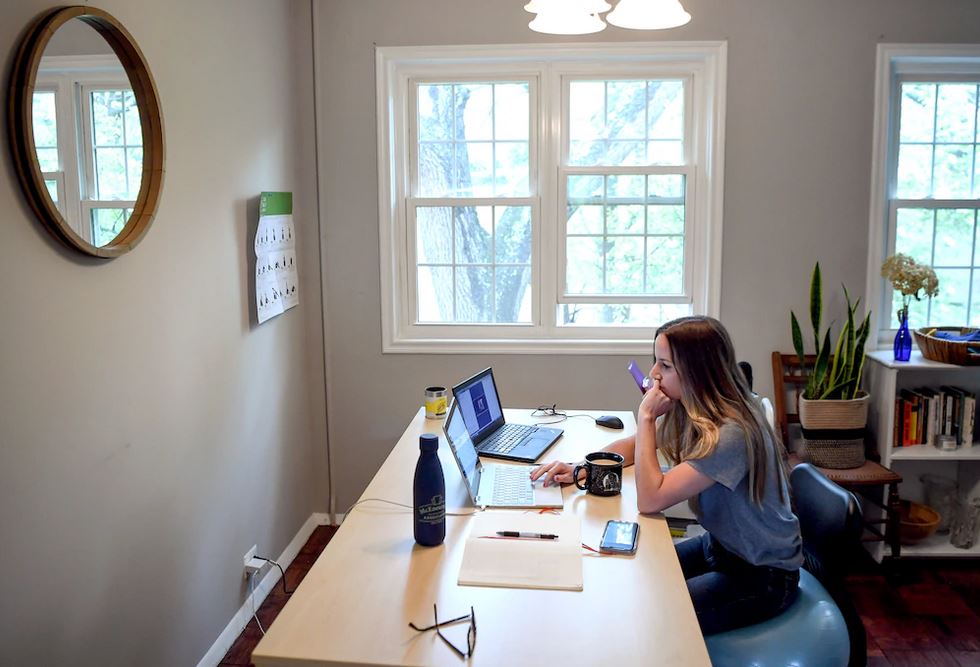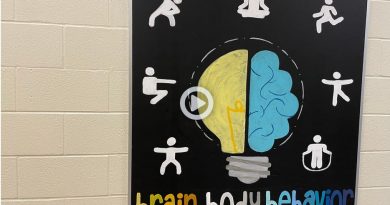Live vs. tape-delayed: How two approaches to online learning change life for teachers and students
In Virginia, two school districts are taking opposite approaches: Alexandria City Public Schools is offering synchronous learning, while Arlington Public Schools chose asynchronous instruction.
The Washington Post tracked a teacher and a student from each division through one day of class in the new world order.
6:30 a.m.
Alexandria
Colleen McEnearney’s iPhone still goes off at 6:30 a.m.
At the sound of the alarm, she still showers, dries her hair, dresses for work. But rather than drive 20 minutes to school, she walks 30 steps to her dining room table, alongside which she keeps a cart filled with pens, papers, and device chargers that she snagged from her desk before schools closed.
By 8:15 a.m., she’s seated before two computers: one that she will deploy to share her screen with students, one that she will use to manage access to the Zoom call. In the 45 minutes left before class, she ignores her inbox, which fills swiftly with links to Zoom meetings and parent queries, and inspects her lesson plans. She mouths each sentence of the day’s slide show. She checks for typos. She click-tests every hyperlink.
“I want it to work as smoothly as humanly possible,” McEnearney said, “although I know my Zoom is going to freeze at least once, and so are my students’ Zooms.”
It’s about then that her student Madeline Arnold, 13, wakes up.
Madeline used to rise early, to allow time for the walk to school. Now, she gets up an hour before her first class.
The first thing she does is make her bed, which she never used to do. That’s because her bed never used to be seen by her math teacher, let alone dozens of her classmates.
Madeline changes into leggings and a sweatshirt, grabs a yoga mat, and embarks on a half-hour of required physical therapy. (“I’m growing super fast,” she said, “so my pelvis is unaligned.”) She remains on the floor with a foam roller until her phone pings with a reminder.
Five minutes until Algebra I.
Arlington
Fourth-grade teacher Maria White doesn’t use an alarm anymore.
She wakes about 7 a.m., an hour and a half later than she did pre-virus. Her kids, 3 and 6, followed soon after. White’s husband, an IT specialist, taps at his computer. White ambles to the kitchen to sip coffee and make pancakes.
As her children eat, White opens her laptop. She scans her inbox to see if students are having technical troubles. If not, she checks answers to a daily question she posts on Google Classroom: “What is your favorite breakfast?” “Where is your favorite place to read in your house?”
White pauses, frowning, at a row of emoji. Weeks ago, she set a 15-emoji cap. (Otherwise, Google glitches.) It hasn’t stopped the flood of chocolate bars and sunglass-adorned smiley faces.
White’s own children finish eating. She closes the laptop, starts clearing the dishes.
Her student Kaitlin Reilly, meanwhile, is facing a tight schedule.
Wake-up is at 6 a.m. Breakfast is strawberries, banana bread, and her daily vitamin, inhaled in the kitchen alongside Mom, Dad, an au pair, and three younger siblings. Kaitlin, 10, brushes her hair and teeth, yanks on clothes, and lines up in front of the television. Together, the family finishes a seven-minute YouTube workout video.
By 9 a.m., per the “Reilly Academy” schedule developed by her parents, it’s time for a morning meeting in the living room. They sing “The Hello Song” and recite the Pledge of Allegiance. They discuss the day ahead: who will do what, where, when.
Wrapping things up, 3-year-old Mikey Reilly opens the door to the porch and pokes his head out. Speaking extra loud and extra clear, the way he used to announce the weather at preschool, he delivers the forecast.
“Usually he’s pretty good,” Kaitlin said, “but sometimes if it’s warm out, he’ll just say it’s VERY COLD.”
9 a.m.
Alexandria
McEnearney used to be at school from 8 a.m. to 3:15 p.m. Now, her teaching day is 90 hectic minutes.
Between 9 and 10:30 a.m., she must teach Algebra I to more than 70 eighth-graders, split into three 30-minute “ClassZooms.” She guides them through a slide show whose colorful pages declare a daily “Learning Target.” On a recent Friday, it was to “write the equation of a line in the slope-intercept form given slope and a point.”
McEnearney displays the problem “1 = -1/2(-4) + b” and asks her gallery of pixelated students how to solve it. There are too few participants, she knows: McEnearney hasn’t heard from about 30 of her 109 students since the shutdown, absences she attributes to poor Internet, a dearth of devices or unstable home situations.
“Some of our class is missing,” she said, “but that’s okay.”
A boy named Evan unmutes himself to suggest subtracting two from each side. McEnearney nods and asks a girl named Abigail for the next step. But Abigail, whose empty black rectangle means she forgot to turn on her camera, can’t say.
“Sorry,” Abigail said. “I haven’t been paying attention. I had to do something.”
Madeline Arnold knows the answer, but her microphone isn’t working. Her technological troubles continue when McEnearney splits the class into breakout groups — videoconferences of three to four people — and asks them to tackle a sheet of problems.
Madeline’s group can’t find the link to the sheet. Maybe, the three girls ask one another, a classmate named Ruth has it? Madeline messages to check: She doesn’t.
“Well, if Ruth doesn’t know,” said one girl, “then I don’t know if anyone knows.”
A notification pops up: “Breakout room will close in 58 seconds.” Madeline clicks out of math class without locating the worksheet.
She checks the clock: 73 minutes until science. After that, just enough time to make lunch before a choir elective at 1 p.m.
Madeline launches a new Web page. If she works quickly, she figures, she can finish all of her Chinese assignments before she has to get back on Zoom.
Arlington
If none of her fourth-graders need help, Maria White likes to spend the morning with her kids.
She guides her son through readings and gives him BrainPop quizzes on science and math. She takes her daughter outside for a walk or helps her write her name. Around noon, White’s husband takes a break from work so the couple can make lunch: chicken nuggets or Bagel Bites for the kids, sandwiches, and salads for the grown-ups.
“It’s nice,” she said, “because now I have some freedom with my kids.”
Her student Kaitlin Reilly, meanwhile, is staring at her iPad. Per the Reilly schedule, she must complete assignments for White’s class, language arts, and geometry by midday.
White assigns three types of homework: Students listen to a prerecorded video of White reading a book and comment their best guess at the text’s theme; or they study an excerpt of a text, then write a post distinguishing between “main ideas” and “details.”
The third kind is Kaitlin’s favorite: writing mini-essays to answer questions such as, “Why is learning at school more fun?” She calls the period between 9:15 and 10 a.m. her “Writer’s Workshop.”
Writing, which she does cocoon at the desk beneath her loft bed, makes her calm, Kaitlin said. She gets so focused on the sentences that she forgets why she is mad at her siblings. Forgets even the virus.
Other things are harder to forget.
“There are more people in your classroom than at your house,” she writes. “You get to see your teachers and friends, you get to talk [and] work with them.”
“I think,” she concludes, “that learning at school is better.”
1 p.m.
Alexandria
Virtual class done, McEnearney begins Zooming with colleagues — comparing virtual curriculums, debating how to assess students fairly.
Between 1 and 3 p.m. comes McEnearney’s favorite part of the day: student conferences. Her eighth-graders can sign up for one-on-one Zoom sessions, ranging from 15 minutes to an hour, to discuss anything they want.
Some raise academic concerns. But one A student, who has been signing up weekly, almost never mentions school.
“We talk about her siblings, the food she’s been making with her mom, how she’s mad at her younger sibling,” McEnearney said. “All the things she used to tell me before school or during those little moments in the day that now we don’t have.”
She keeps working until 4, around when she used to arrive home from school. Then she forces herself to close both laptops. She slips in EarPods, picks a podcast, and wanders outdoors.
Madeline Arnold’s day is done much earlier than it used to be.
By 1:30 p.m., she has attended all her online classes and, usually, finished all her homework. Before the virus, she would have headed to Holy Cow in Del Ray for burgers with her three best friends.
She wiles away each afternoon a little differently these days: episodes of “Grey’s Anatomy,” running laps on a track, video games with her parents, writing songs.
And reading. She is almost done with Jennifer Niven’s “Holding Up the Universe,” which she was always too busy to start before.
“It’s kinda weird,” she said, “because you have more free time, but you don’t have anything to do.”
Arlington
Maria White’s husband finishes work at 3 p.m., allowing hers to begin. She plunges into virtual staff meetings, heading to her bedroom and closing the door to ensure quiet.
She examines students’ responses to the day’s assignments, offering feedback in comments she hopes they read. She develops homework for the next day. She videotapes herself reading books. (She is terrible, she has learned, at doing voices.) She messages parents: Could you access Google Classroom today? How did your child feel about the workload — too much? Too little?
“The hardest thing is not being able to individualize instruction,” she said. “Some kids need an extra review on certain skills, and in a classroom, you would just pull them over.”
That’s impossible now. White likes the convenience of asynchronous learning, she said, but she is planning optional 9:30 a.m. video calls.
Kaitlin Reilly would like that, she said.
It would be good to see her friends. And she is used to video calls: That’s how she visits with her grandparents.
In the evening FaceTimes, she tells them about her day and what she is learning. She tells them that she loves them and that they have to stay healthy.
Later, she confides to her journal, which she started a few weeks ago.
“This is like a piece of history,” Kaitlin said, “so I thought I should keep a diary.”
She writes until she’s too sleepy to hold the pen. Then, she turns off the lights.
Source: https://www.washingtonpost.com/local/education/live-vs-tape-delayed-how-two-approaches-to-online-learning-change-life-for-teachers-and-students/2020/04/25/250fb7d0-7bfe-11ea-9bee-c5bf9d2e3288_story.html?wpisrc=nl_sb_smartbrief












